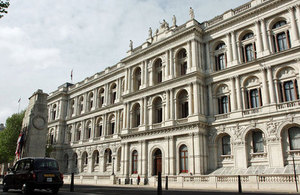UK response to reports of sexual violence in the Syrian conflict
A case study on the UK response to reports of sexual violence in the Syrian conflict from the 2013 Human Rights and Democracy Report.

The UN Commission of Inquiry reported that sexual violence has played a prominent role in the conflict in Syria. It occurs during raids, at checkpoints, and in detention centres and prisons across the country.
It occurs during raids, at checkpoints, and in detention centres and prisons across the country. The threat of rape is used as a tool to terrorise and punish women, men and children. Underreporting and delayed reports of sexual violence are endemic, making an assessment of its scale difficult.
The UK response has recognised the need to support survivors of sexual violence with appropriate humanitarian assistance; to improve the ability of stakeholders to document and investigate crimes of sexual violence; and to ensure that any evidence collected will be made available to the Commission of Inquiry and, where appropriate, in support of transitional justice, and conflict and post-conflict resolution. The UK has worked directly with the Chair of the Commission of Inquiry, sharing understanding and developing ideas on how best to ensure that potential peace settlements deal directly with the issue of sexual violence and other human rights violations.
We have run two projects on the Syrian borders with Physicians for Human Rights, an international NGO that uses medicine and science to tackle severe human rights violations against individuals. In both cases, we have deployed members of the UK Team of Experts to improve the capacity of health professionals and human rights defenders to document crimes and human rights abuses, including sexual violence. Case files are being stored should they be useful in any national or international justice process. We are also supporting the Syrian Commission for Justice and Accountability to build Syrian capacity to investigate allegations of sexual offences amounting to war crimes, and crimes against humanity perpetrated in the context of the current conflict.